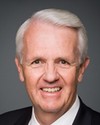Thank you, Mr. Chair; I'll be as brief as I can.
I’m pleased to provide the government’s response to chapter 1 of the Auditor General’s 2014 spring report, specifically how we’ll act on the report’s recommendations. I have with me today Kim Gowing, who is a director in the pensions branch, and also I have Bayla Kolk, the assistant deputy minister responsible for pensions and benefits.
The Auditor General's 2014 Spring Report audited the three main public sector pension plans. These plans cover substantially all of the employees in the public service of Canada, the Canadian Armed Forces and the RCMP, as well as employees of certain public service corporations.
The government agrees with the Auditor General's findings and recommendations. We are pleased that the report confirms that the Treasury Board Secretariat, National Defence and the RCMP are meeting their legislative obligations and assuming their responsibilities.
With respect to the Auditor General’s first recommendation concerning the periodic assessment of these plans, we recently reviewed them and have taken steps to help ensure their long-term sustainability. We have increased the employee contribution rates for the public service to reach a 50-50 employer-employee cost-sharing ratio for public servants with comparable increases for the Canadian Armed Forces and the RCMP. We've also raised the normal age of retirement from 60 to 65 for employees who joined the public service after January 1, 2013. These reforms are expected to provide $2.6 billion in savings by the fiscal year 2017-18, and more than $900 million in annual savings after that.
In addition to helping ensure the sustainability of plans, these actions will contribute to the ongoing stability of our pension costs as a percentage of pensionable payroll. To further strengthen collaboration on sustainability among departments, this year the secretariat will establish an interdepartmental committee at the assistant deputy minister level that includes the Department of Finance, the RCMP, and National Defence. This committee will manage pension-related issues across departments and coordinate work across departments on the government’s response to the Auditor General’s report.
Regarding the Auditor General’s second recommendation, the secretariat will continue to work in collaboration with its partners to complete the development of the funding policy for all three plans. This policy will clearly identify the funding and financial preferences of the plan sponsor, establish parameters for monitoring and evaluating funding risks, and develop benchmarks for evaluating plan sustainability.
The third recommendation calls for a consolidated report.
In this area, the secretariat will collaborate with National Defence and the RCMP to develop a proposal for a new consolidated report for the sponsor's consideration. If the proposal is accepted, the goal is to introduce this report for 2015-2016.
The fourth recommendation focuses on reviewing our governance practices.
Again, the secretariat will collaborate with its partners to review the governance practices for these plans, and make recommendations to the plan sponsor. This work will serve to help strengthen the governance framework of the public sector plans, and help ensure they remain affordable and sustainable.
The fifth recommendation calls for assessing the cost of funding pre-2000 pension liabilities.
The Department of Finance is better positioned to speak to this recommendation. However, the secretariat has committed to supporting the Department of Finance in concluding the assessment of their obligations.
Mr. Chair, we place great importance on the financial integrity of these plans, and present detailed information on the plans and their liabilities through the public accounts in accordance with the standards prescribed by the Public Sector Accounting Board.
Finally, while the Auditor General did not examine the sustainability of the plans, we will continue to support efforts to ensure their affordability and sustainability in a way that is fair to both taxpayers and employees.




